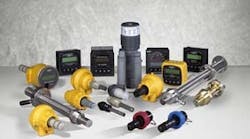Standard in the industry today, as it has been for years, is the 4-20 milliamp signal. This universal output allows the end user to take any process parameter, scale the unit measurement over the 4-20 mA span, and get a linear representation of that measurement back at the PLC.
For OEMs measuring several parameters in their systems and also watching costs, this is not an option. Transmitters feeding to a PLC are the norm.
During the initial years of microprocessor-based transmitters, displays were used for calibration and also provided the added benefit of a local process display. Additional features such as relays and open collector outputs soon followed.
GF Piping Systems has been at the forefront of this transmitter evolution with Signet instrumentation. With standard 4-20mA-only option, relay outputs and two channel devices, the Signet line of industrial transmitters gives the OEM/end-user a wide variety of choices. Mounting options have expanded to include integral, remote, and 1/4 DIN panel mount displays.
GF Piping System's instrumentation product family.
In the always-competitive OEM market, cost concerns drive buying decisions. GF Piping Systems has added a multi-parameter controller which provides up to six sensor inputs, four 4-20mA outputs and relay outputs, in order to simplify and lower overall costs to the OEM.
For OEMs using central touch-screen displays, another way to lower measurement costs in an increasingly competitive market is to return to basics with blind transmitters. The Signet 2537 sensor with 4-20mA option combines the stability and reliability of microprocessor-based transmitters along with reduced costs by eliminating unnecessary displays.
GF Piping Systems offers several sensing device choices:
- Paddlewheel Flow The 2537 Paddlewheel Flow Sensor offers a 4-20 mA blind output option. It has a reduced-cost on-board display for calibration only, and offers the same dynamic flow range as the proven 2636 sensor.
- Magnetic Flow The very successful plastic insertion 2551 and newer hot tap style 2552 both offer a wide flow measurement range of 0.1533 feet per second, and can be spanned for other ranges including forward and reverse flow with the new 3-0250 calibration software tool.
- pH/ORP Available in submersible or inline styles, and compatible with all DryLoc series pH and ORP electrodes, the 2750 4-20mA blind transmitters are self-configuring with probe recognition (pH or ORP) and have an optional push-button/LED calibration feature with buffer recognition allowing quick, easy calibrations.
- Conductivity/Resistivity For integral or remote mount applications, the 2850 is compatible with all Signet conductivity/resistivity electrodes. The 2850 electronics are field configurable for any Signet offered cell constants in a wide variety of ranges.
- Temperature For inline or submersible applications, the 2350 comes configured for 32212°F, and can be spanned for other ranges with the new 3-0250 calibration software tool.
- Pressure Available in three pressure ranges, the 2450 can be used for inline or submersible applications. The 2250 can be used to hydrostatic level measurement. These sensors can be spanned for other ranges with the new 3-0250 calibration software tool.
All these devices offer accurate, reliable sensing combined with cost-effectiveness performance. In todays cost-conscious environment, OEMs will find these products to provide a reliable solution for flow and pH/ORP measurement requirements.
